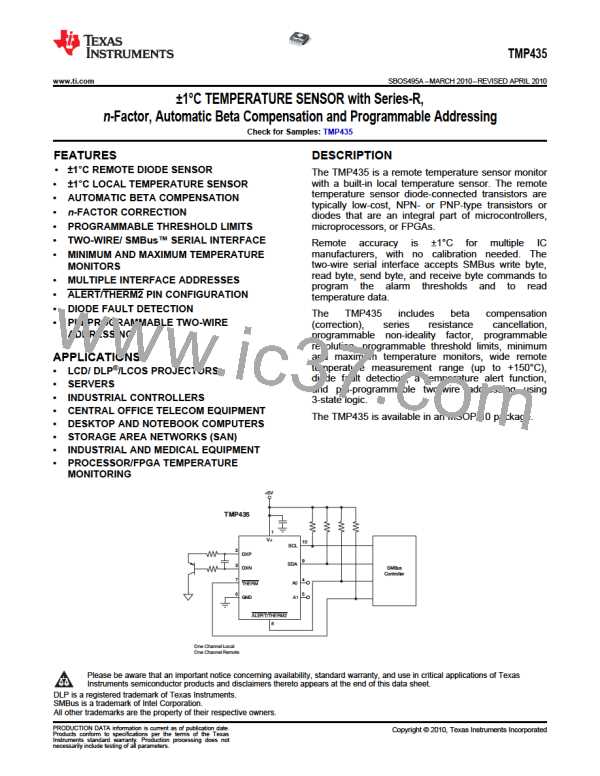TMP435
SBOS495A –MARCH 2010–REVISED APRIL 2010
www.ti.com
Remote Sensing
3. Base resistance < 100Ω.
4. Tight control of VBE characteristics indicated by
small variations in hFE (that is, 50 to 150).
The TMP435 is designed to be used with either
discrete transistors or substrate transistors built into
processor chips and ASICs. Either NPN- or PNP-type
transistors can be used, as long as the base-emitter
junction is used as the remote temperature sense.
NPN transistors must be diode-connected. PNP
Based on these criteria, two recommended
small-signal transistors are the 2N3904 (NPN) or
2N3906 (PNP).
transistors
diode-connected (see Figure 13).
can
either
be
transistor-
or
Measurement Accuracy and Thermal
Considerations
Errors in remote temperature sensor readings are
typically the consequence of the ideality factor and
current excitation used by the TMP435 versus the
manufacturer-specified operating current for a given
transistor. Some manufacturers specify a high-level
and low-level current for the temperature-sensing
substrate transistors. The TMP435 uses 6mA for ILOW
and 120mA for IHIGH. The device allows for different
n-factor values; see the N-Factor Correction Register
section.
The temperature measurement accuracy of the
TMP435 depends on the remote and/or local
temperature sensor being at the same temperature
as the system point being monitored. Clearly, if the
temperature sensor is not in good thermal contact
with the part of the system being monitored, then
there is a delay in the response of the sensor to a
temperature change in the system. For remote
temperature sensing applications using a substrate
transistor (or a small, SOT23 transistor) placed close
to the device being monitored, this delay is usually
not a concern.
The ideality factor (n) is a measured characteristic of
a remote temperature sensor diode as compared to
an ideal diode. The ideality factor for the TMP435 is
trimmed to be 1.008. For transistors whose ideality
factor does not match the TMP435, Equation 6 can
be used to calculate the temperature error. Note that
for the equation to be used correctly, actual
temperature (°C) must be converted to Kelvin (K).
The local temperature sensor inside the TMP435
monitors the ambient air around the device. The
thermal time constant for the TMP435 is
approximately two seconds. This constant implies
that if the ambient air changes quickly by 100°C, it
would take the TMP435 about 10 seconds (that is,
five thermal time constants) to settle to within 1°C of
the final value. In most applications, the TMP435
package is in thermal contact with the PCB, as well
as subjected to forced airflow. The accuracy of the
measured temperature directly depends on how
accurately the PCB and forced airflow temperatures
represent the temperature that the TMP435 is
measuring. Additionally, the internal power dissipation
of the TMP435 can cause the temperature to rise
above the ambient or PCB temperature. The internal
power dissipated as a result of exciting the remote
temperature sensor is negligible because of the small
currents used. For a 5.5V supply and maximum
conversion rate of eight conversions per second, the
TMP435 dissipates 1.82mW (PDIQ = 5.5V × 330mA).
If both the ALERT/THERM2 and THERM pins are
each sinking 1mA, an additional power of 0.8mW is
dissipated (PDOUT = 1mA × 0.4V + 1mA × 0.4V =
0.8mW). Total power dissipation is then 2.62mW
(PDIQ + PDOUT) and, with a qJA of 165°C/W, causes
the junction temperature to rise approximately
0.432°C above the ambient.
n - 1.008
TERR
=
´ [273.15 + T(°C)]
1.008
Where:
•
•
•
n = Ideality factor of remote temperature sensor
T(°C) = actual temperature
TERR = Error in TMP435 reading because n ≠
1.008
•
Degree delta is the same for °C and K
(6)
(7)
For n = 1.004 and T(°C) = 100°C:
1.004 - 1.008
TERR
=
´ (273.15 + 100°C)
(
)
1.008
TERR = 1.48°C
If a discrete transistor is used as the remote
temperature sensor with the TMP435, the best
accuracy can be achieved by selecting the transistor
according to the following criteria:
1. Base-emitter voltage > 0.25V at 6mA, at the
highest sensed temperature.
2. Base-emitter voltage < 0.95V at 120mA, at the
lowest sensed temperature.
26
Submit Documentation Feedback
Copyright © 2010, Texas Instruments Incorporated
Product Folder Link(s): TMP435

 TI [ TEXAS INSTRUMENTS ]
TI [ TEXAS INSTRUMENTS ]